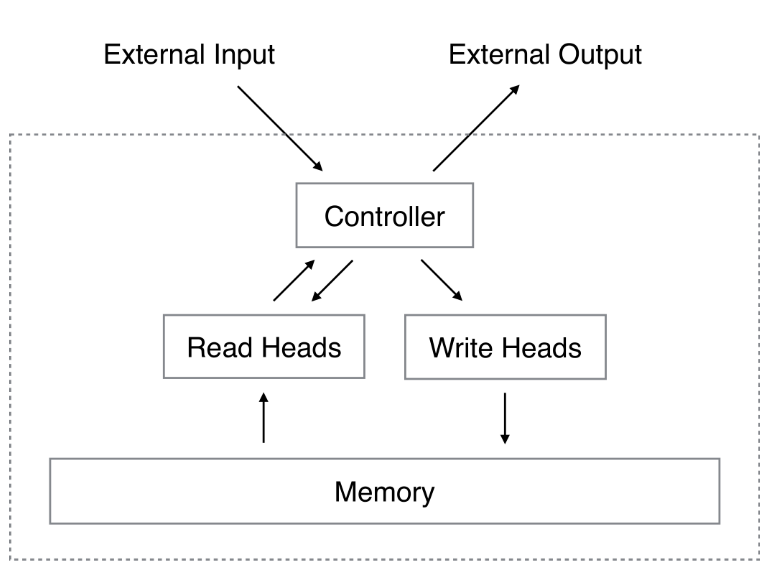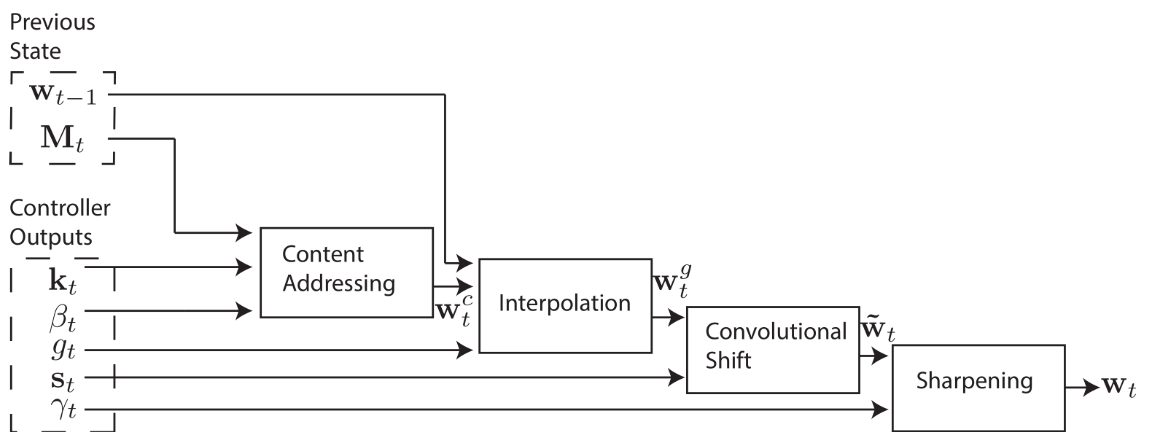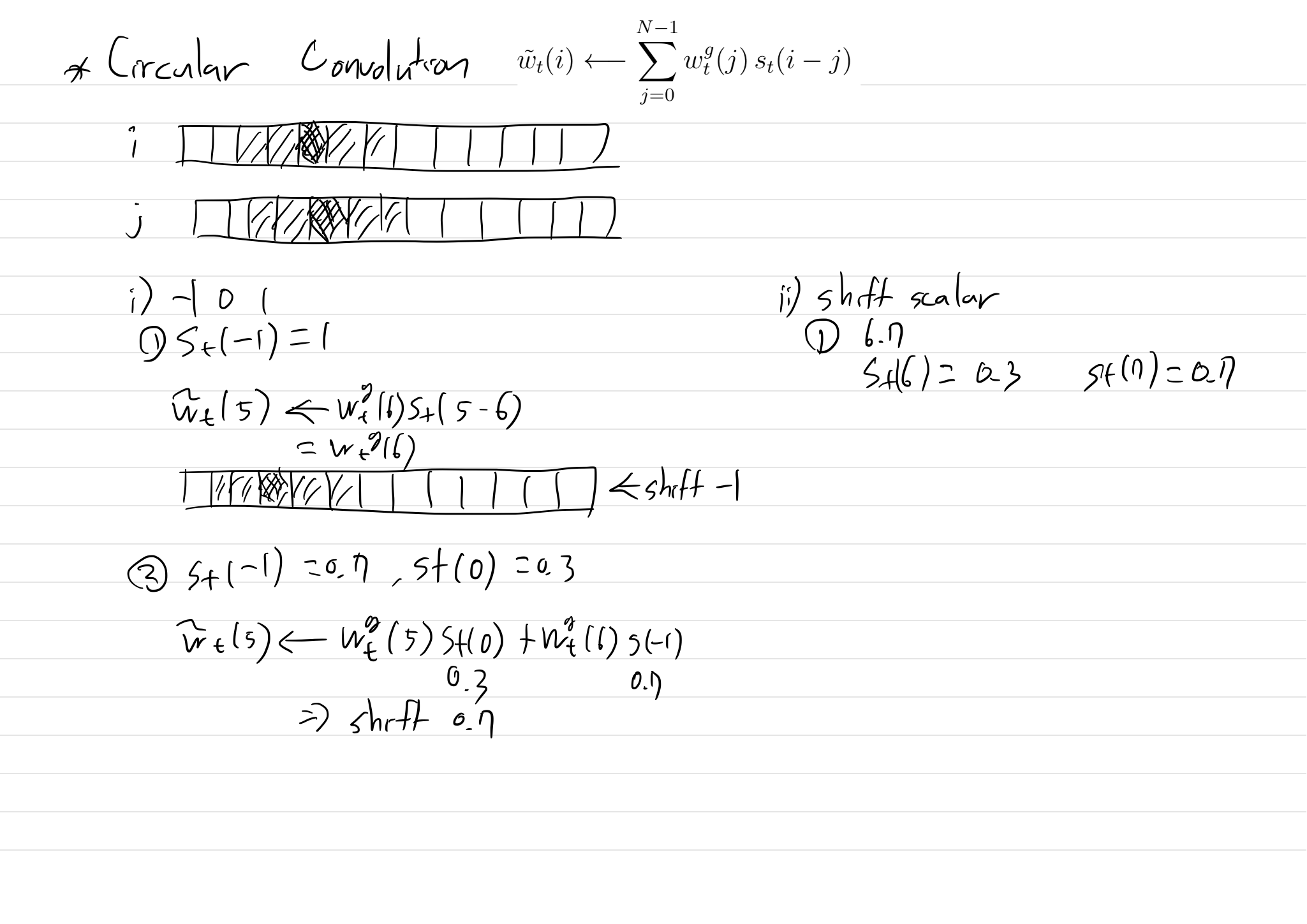Neural Turing Machine
in Studies on Deep Learning, Deep Learning
WHY?
기존의 Turing Machine, 혹은 Von Neumann architecture 구조를 가진 컴퓨터들은 elementary operations, logical flow control, external memory라는 근본 메커니즘을 가진다. 기존의 machine learning 기법들은 이 세가지 메커니즘 중 첫번째에 집중해왔다. 최근 나온 RNN구조는 Turing complete하여 이를 활용하여 Neural Truing Machine을 만들 수 있다. 기존 Turing machine과는 다르게 NTM은 gradient descent로 학습이 가능하다.
WHAT?
 NTM의 기본 구조는 그림과 같다. Controller는 input과 output을 통하여 외부와 interaction하고 Head(TM 구조에 있는 명칭)를 통하여 읽고 쓴다. 하지만 정확히 메모리를 읽고 쓰는 TM과는 달리 NTM은 attentional focus를 통하여 ‘blurry’ 읽기와 쓰기 작업을 한다.
NTM의 기본 구조는 그림과 같다. Controller는 input과 output을 통하여 외부와 interaction하고 Head(TM 구조에 있는 명칭)를 통하여 읽고 쓴다. 하지만 정확히 메모리를 읽고 쓰는 TM과는 달리 NTM은 attentional focus를 통하여 ‘blurry’ 읽기와 쓰기 작업을 한다.
메모리에 대한 읽기와 쓰기는 다음과 같이 이루어진다. 우선 \mathbf{M}_t을 t시점의 N x M사이즈를 가진 memory matrix라고 할 떄 N은 memory location, M은 memory의 vector size로 정의된다. w_t는 N개의 메모리에 주의를 기울이는 weighting이다. 이 가중치로 메모리를 읽은 결과 M차원의 read vector r_t가 도출된다. \Sigma_i w_t(i) = 1\\ r_t \leftarrow \Sigma_i w_t(i)M_t(i) 쓰기는 지우기와 더하기 두 가지로 구성되어있다. e_t는 erase vector, a_t는 add vector이며 이를 통하여 메모리에 수정을 가한다. \mathbf{\tilde{M}}_t(i)\leftarrow \mathbf{M}_{t-1}(i)[\mathbf{1} - w_t(i)\mathbf{e}_t]\\ \mathbf{M}_t(i)\leftarrow \mathbf{\tilde{M}}_{t-1}(i) + w_t(i)\mathbf{a}_t  메모리에 대하여 읽고 쓸 때 활용하는 w는 Addressing mechanism을 통하여 도출된다. Addressing mechanism은 focusing by content와 focusing by location으로 구성된다. Content Addressing에서는 내용간의 유사도를 확인하는 방법으로 cosine similarity를 사용한다.
메모리에 대하여 읽고 쓸 때 활용하는 w는 Addressing mechanism을 통하여 도출된다. Addressing mechanism은 focusing by content와 focusing by location으로 구성된다. Content Addressing에서는 내용간의 유사도를 확인하는 방법으로 cosine similarity를 사용한다. w_t^c(i) \leftarrow \frac{exp(\beta_t K[\mathbf{k}_t, \mathbf{M}_t(i)])}{\Sigma_j exp(\beta_t K[\mathbf{k}_t, \mathbf{M}_t(j)])}\\ K[\mathbf{u}, \mathbf{v}] = \frac{\mathbf{u}\cdot \mathbf{v}}{\|\mathbf{u}\|\cdot\|\mathbf{v}\|} Focusing by location에서는 우선 content에서 사용한 weight를 가져와서 이를 얼마나 활용할지 gate weighting을 한다. 그 다음 weight를 회전시켜 memory location간의 관계에 weighting을 줄 수 있는 shift weighting을 한다. 그리고 마지막으로 이러한 weighting의 정밀도를 올리기 위하여 sharpening을 한다. w_t^g \leftarrow g_t w_t^c + (1- g_t)w_{t-1}\\ \tilde{w}_t(i) \leftarrow \Sigma_{j=0}^{N-1} w_t^g(j)s_t(i-j)\\ w_t(i) \leftarrow \frac{\tilde{w}_t(i)^{\gamma t}}{\Sigma_j\tilde{w}_t(i)^{\gamma t}} shift weighting의 식이 익숙하지 않을 수 있는데 기본적으로 다음과 같이 weighting의 회전이동의 식이라고 생각하면 된다.  Controller Network는 LSTM 혹은 FC로 구성할 수 있다.
Controller Network는 LSTM 혹은 FC로 구성할 수 있다.
So?
기본 LSTM보다 일정한 sequence를 copy, repeat copy, associative recall하는 작업을 잘 해내었다. 또한 Dynamic N-gram과 priority sort에서도 좋은 성과를 거두었다.
Critic
기본적으로 external memory를 활용하는 lstm이지만 잘 발전시켜 훈련가능한 컴퓨터 구조를 제안한 것이 인상깊었다. 하지만 컴퓨터라고 하기엔 너무 기본적인 것도 잘 하지 못하는(repeat copy에서 일정 횟수 이후에 정지하는 것에 실패하였다.) 것이 아쉬웠고 좀 더 발전이 가능한 아이디어 같다.
